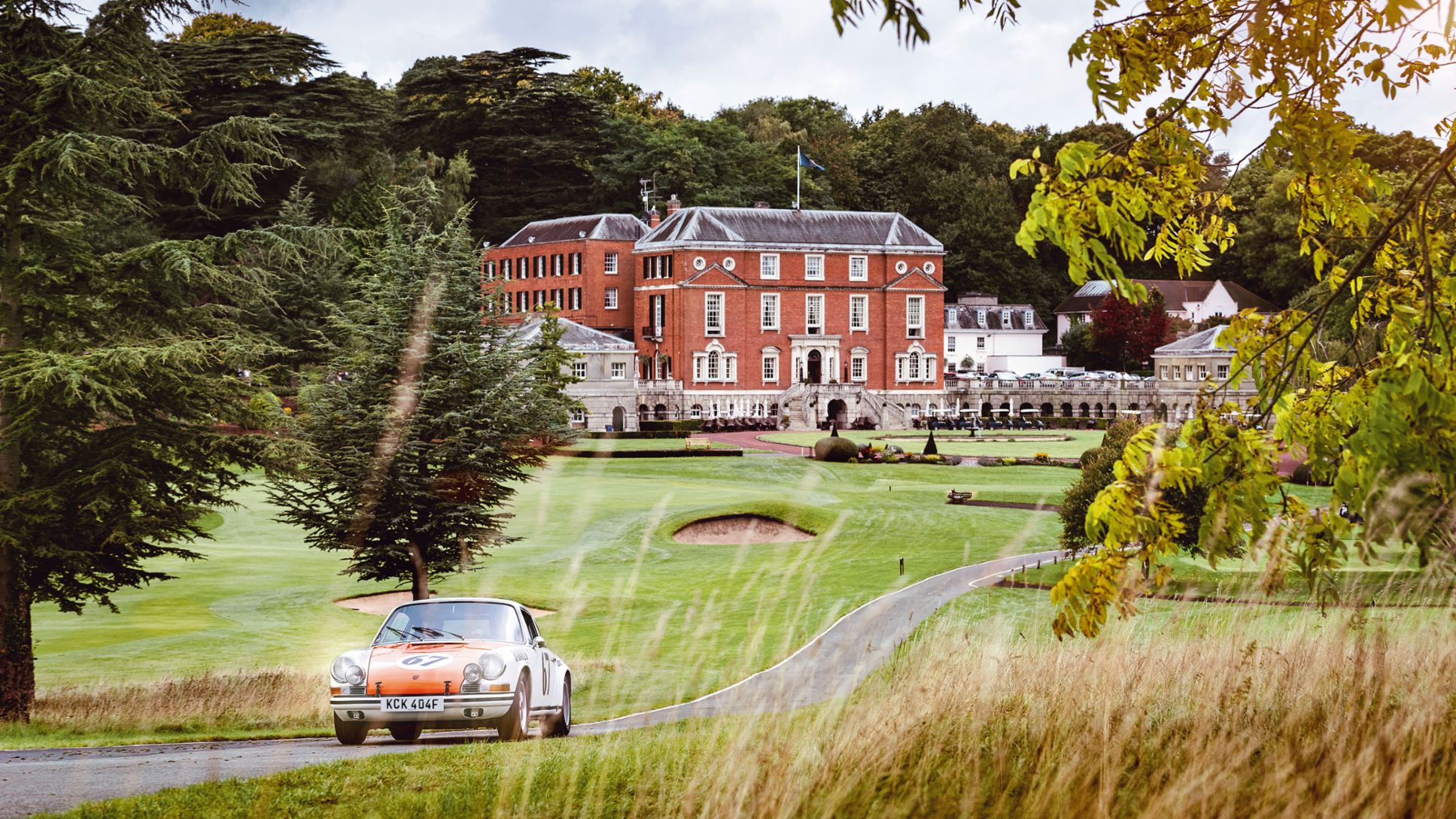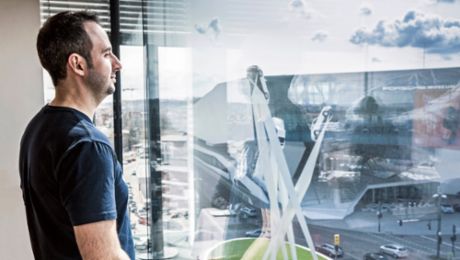His work demands uncompromising objectivity as the basis for accurate forecasts. Yet he harbors a subjective fondness for a very special car: his Porsche 911 T/R.
It hisses on occasion when it feels like it, sometimes with startling vehemence. Arndt Ellinghorst is fond of his 911 T/R, including its idiosyncrasies. “When you get inside and drive, you leave everything else behind.” The interior of the Light Ivory 911 is purist in the extreme, reduced to its very essence. It has nothing that would distract the driver, because driving is what it’s all about. When Ellinghorst, forty-six, sits down behind the wheel of his sports car, he’s not thinking about anything else and all is right with the world. That much is immediately clear.
Ellinghorst looks fresh: a touch of makeup highlights his tan, and his hair lies in perfectly symmetrical waves. After greeting us, he reveals that he has just made a guest appearance on a live news broadcast with CNBC. As an automotive analyst and industry insider, he is in demand when journalists want to know about mobility. This time, the subject was not the cars of the future, but rather the future of cars, of which Ellinghorst has a rather rosy view. “Stock prices in the industry are volatile, of course, but I think the trajectory is generally positive,” he says. He is firmly convinced that the global automotive industry will continue to grow. “Mobility remains of crucial importance to customers. True, the industry is undergoing change. Developments like automated vehicles, new drive systems, and digital applications are generating enormous pressure for change,” he remarks. But one shouldn’t underestimate the creativity of carmakers. “Apple, Google, and Uber are great companies, but I wouldn’t advise them to build cars.”
He is an analyst, not a clairvoyant
Ellinghorst works in the London office of the U.S. firm Evercore ISI. He is head of global automotive research, or, in other words, he knows the industry. Though he makes investment recommendations, he is an analyst, not a clairvoyant. “I’m often wrong, but thankfully more often I am right,” he says. “Otherwise, people wouldn’t ask me for advice.” He weighs the future without being too weighed down by the past.
Ellinghorst takes a down-to-earth approach to analysis. He looks closely at indicators such as price–earnings ratios, cash flow, and enterprise values. Then he calculates probabilities. “But that’s where I go beyond the content per se,” he notes. So does his gut instinct in fact play a role? “Seventy percent of what I do consists of hardcore observation and study: gathering data and analyzing developments. The rest is intuition.” That approach also fits his private life. Ellinghorst and his family have lived in London for nine years. He is a European in his heart and rose with tears in his eyes on the morning of June 24, 2016, after the United Kingdom voted for Brexit. In his view, the decision to leave the EU is a loss for all concerned. What about citizenship—would he consider exchanging his German passport for a British one? “If my boys start preferring cricket over soccer, I might give it a thought.” Ellinghorst left his position as managing director at Credit Suisse more than four years ago in order to build up and lead the European business for Evercore ISI. As one might expect, he carefully analyzed the situation beforehand (that is, after all, his vocation). But there were no guarantees that his new venture would be a success. “Plans don’t always work out, but I believe drive and determination usually lead to success.”
Dinner in the grandiose hall of the Royal Automobile Club
Today he heads a team of twenty-five people. “They’re all cool and young. They’re real doers, in a word,” he says at our dinner in the grandiose hall of the Royal Automobile Club. The industry needs agents provocateurs, he claims. “You can fence with a saber—or with a foil.” Ellinghorst himself has been known to push the envelope. “That’s the only way to keep the dialogue moving in this sector,” he remarks. But he is also very prudent. Provocation may be suitable for getting people’s attention, but analysis is subject to very different rules. “You have to be informed at all times and be certain in your own mind before making any recommendations to investors.”
“I want to offer products in good conscience. That is much more important to me than rapid growth. I prefer to see profitable growth than growth at any price,” he says. The question of whom he actually works for is more difficult. “I serve the capital market and see myself as an intermediary between the industry and investors,” is his cryptic reply. Utter discretion is part of his formula for success: silence when the situation requires it and speaking when there is something to say.
His favorite car: a recreation 1968 Porsche 911 T/R
Another moment of silence follows. He sits in his favorite car, a recreation 1968 Porsche 911 T/R. There are only thirty-five originals. All of them are pure racing cars, built to enter and win rallies. Ellinghorst’s recreation is based on the T model’s lightweight chassis with a short wheelbase. Specialists from Mec Auto in Belgium took care of the engine. To generate even more power, they distributed the 2,700 cc of displacement across six cylinders. The car is fired by two fuel pumps from the 26.4-gallon racing tank. The fire extinguisher, should there ever be a need for it, is lodged in the footwell on the passenger side—befitting this 250-hp race car.
The analyst drives his car through the financial district of London. Fuchs wheels in front, Minilite in back. A lot of orange on the outside, a lot of nothing on the inside. Perforated steel instead of foot mats, a racing wheel instead of a multifunction variant. Ellinghorst takes a deep breath, opens the window, and enjoys the vintage automotive sound. He lets the warm engine speed up to nearly 10,000 rpm before shifting gears. He looks out ahead, smiles, and says, “My brother and I used to rebuild VW Karmann Ghias, I wrote the thesis for my degree while at Audi, and then worked for Volkswagen. And now I’m sitting in a Porsche.” There is something fitting about that story.
The 911 T/R on the circuit in Monza
He glances at his watch and then nods to confirm that we still have a few minutes. He talks about Ernst Seiler, also known as “The Hunter,” who used to drive the 911 T/R on the circuit in Monza, the Hockenheimring, the Nürburgring, and many other racing courses. The car was originally built for him, with extra rally headlights, a small racing wheel, a big engine, and a host of other customized features. But now it is time for Ellinghorst to head home, where his three sons are waiting. One of them has surely drawn a new picture. The boys draw pictures all day—of race cars.
He guides the 911 back to its hallowed lodgings southwest of London, near a street evocatively named Drift Road. As soon as the engine cools down, the guard staff will cover the car with a blue hood. Ellinghorst takes one last look back before stepping into his Audi Q7. As he pulls away, we hear him speak into the audio system, “Then let’s shift that option right away to buy.” There he is again, the analyst who looks not to the past but to the future when it comes to cars.
Model: 911 T/R (1968)
Recreation: 2013–2015
Engine: 2.7-liter six-cylinder
Power: 250 hp (186 kW)
Color: Light Ivory with orange
Info
Text first published in the Porsche customer magazine Christophorus, No. 380
Text by Christina Rahmes // Photos by Tim Adler

.jpg/jcr:content/b-Arndt-Ellinghorst-(4).jpg)
.jpg/jcr:content/b-Porsche-911-T-R-(2).jpg)


.jpg/jcr:content/b-Hartmut-Esslinger-beside-his-Porsche-911-Carrera-S-Cabriolet-(2).jpg)